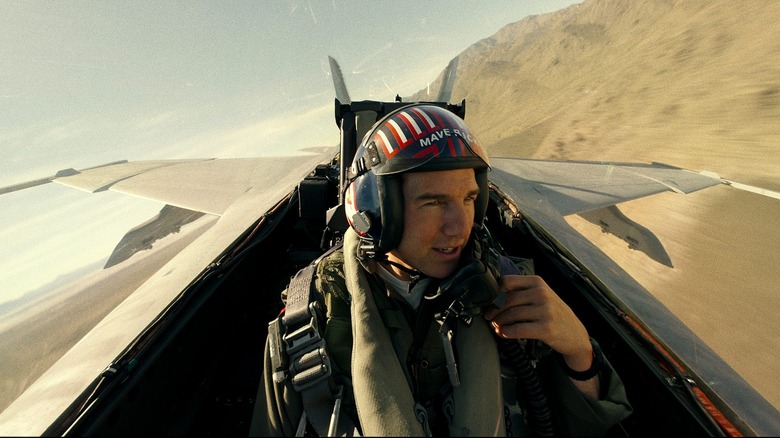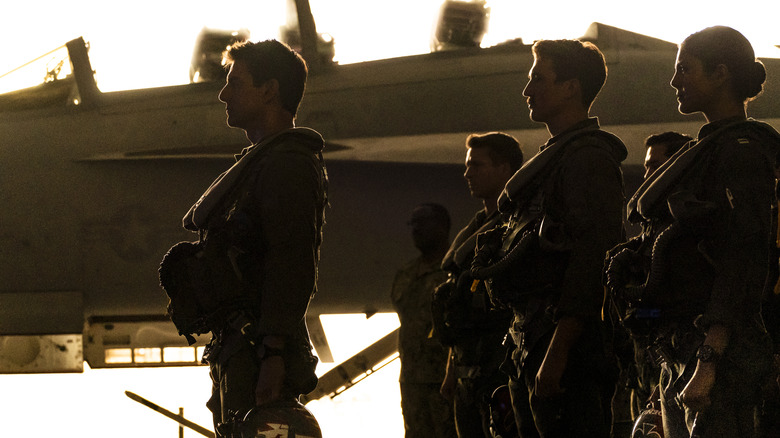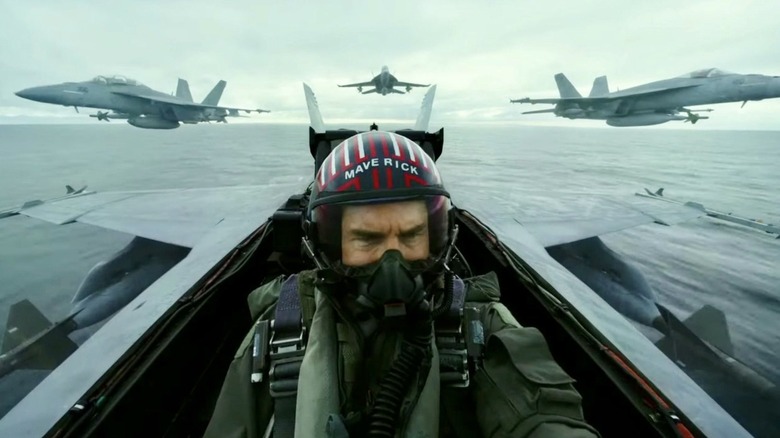Was The Climax Of Top Gun: Maverick Inspired By Star Wars?
On the surface, "Star Wars" and "Top Gun" don't seem to have all that much in common. One is a '70s space opera about a smattering of Rebels taking on a Galactic Empire in a fantasy setting full of aliens, laser swords, and supernatural powers. The other is one of the most '80s movies ever put to the big screen, following the top Naval pilots in the country as they engage in not-so-friendly competition, learn about the power of friendship and mutual respect, and take a break for some sweaty, shirtless volleyball on the beach. Not much crossover between the two blockbusters to speak of ... or is there?
"Top Gun: Maverick" wowed moviegoing audiences across the globe with its practically-shot jet fighter action, nostalgic throwbacks, and stars Jennifer Connelly and Tom Cruise's absolute refusal to age. But the Joseph Kosinski-directed legacy sequel saved the best for last, building up to one of the most spectacular third acts of any blockbuster in recent memory. Led by Cruise's older instructor Pete "Maverick" Mitchell, an elite group of aviators must prepare for the toughest mission they've ever experienced — a precision strike on a uranium enrichment plant, flying well below enemy radar on a target course that may not even be survivable in the first place. For all intents and purposes, it might as well be a suicide mission.
Many viewers couldn't help but notice a few key similarities between this do-or-die set piece and the climactic "Trench Run" featured in 1977's "Star Wars," however. Consider Luke Skywalker and his wingmen flying X-Wing fighters in close proximity to the Death Star for a one-in-a-million shot to Maverick and his pilots' eerily similar predicament. Was this intentional? Was "Star Wars" a main source of inspiration for "Top Gun"?
Connection or coincidence?
It can be hard to pin down exact influences and inspirations from one movie to another — even when the connection seems too specific to be anything else but a direct reference. In this case, however, the broadly familiar climactic showdowns between the two films, involving various aircraft attempting to pull off an impossible task, proved to be nothing more than coincidental. "Top Gun: Maverick" director Joseph Kosinski confirmed as much to /Film previously, noting that while he didn't consciously reference "Star Wars" in any intentional manner:
"I think when Jerry [Bruckheimer] made 'Top Gun,' I think 'Star Wars' was definitely an inspiration for them, so it makes sense that DNA would carry into ours."
As much as it would've made for a great story had the filmmaker answered in the affirmative, it was always far more likely that the immense influence of "Star Wars" on the medium at large would only truly manifest itself through following Joseph Campbell's Hero's Journey. After all, the tried-and-true storytelling method relies on posing the toughest challenge for the hero at their greatest moment of truth. Both Luke and Maverick are pursuing some measure of redemption while in their respective cockpits, journeying headlong into an uncertain fate and even calling upon dead mentors/friends (old Obi-Wan Kenobi for Luke, and dear departed "Goose" for Maverick) for the strength to carry them through it.
Ultimately, these shared connections trace their roots back to the fundamentals of storytelling, rather than an overt influence by "Star Wars." But that doesn't mean the story behind how exactly "Top Gun: Maverick" arrived at its pulse-pounding conclusion isn't worth telling, either.
Into the Danger Zone
So if it wasn't "Star Wars," then how exactly did the final mission of "Top Gun: Maverick" take shape? Well, the answer's actually pretty straightforward. As with the rest of the demanding production, the creative team recruited military advisors and analysts to help plan out the logistics of the plot. While the various cast members were busy attempting to survive the brutal conditions of a Tom Cruise-run boot camp, Kosinski and writer Eric Warren Singer were initially tasked with figuring out the precise details of the action sequence that would serve as the show-stopping highlight of the entire film. It's one thing to put the narrative pieces into place for Maverick's return after several decades and his fraught relationship with Miles Teller's Bradley 'Rooster' Bradshaw, Goose's son. It's another thing entirely to come up with a convincing (and formidable) enough obstacle for the most highly trained pilots in the Navy.
That's where their Naval advisors came in. Kosinski explained it all in an interview with Vulture, saying:
"...we sat down with the Navy and asked, 'What is the absolute scariest, toughest, gnarliest mission that you could ever imagine putting together?' And they laid out this exact mission: low-level ingress into enemy territory through mountains guarded by SAMs with a high g-pull, laser-guided bomb strike."
When looking to incorporate realism into such a critical part of the script, it turns out that the production team was best served by going directly to the experts themselves. Sometimes, truth really is stranger (and scarier) than fiction.


